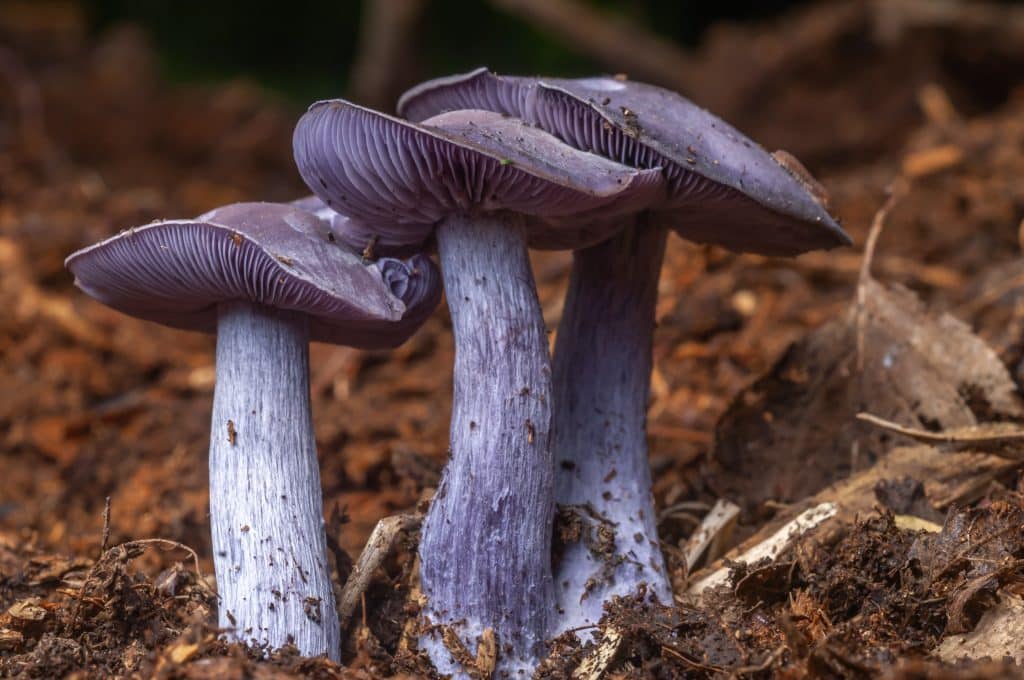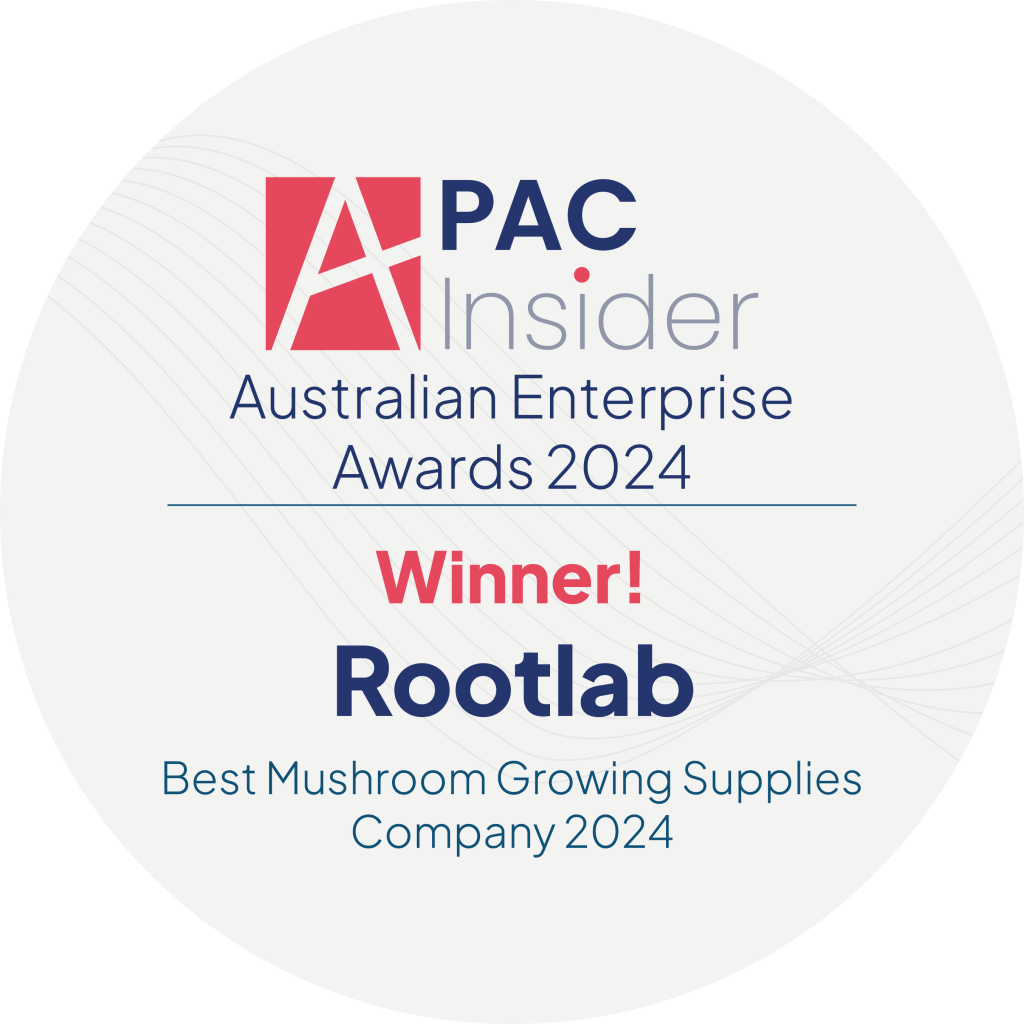
Cultivation Level: Moderate
Wood blewits or Clitocybe nuda are mushrooms grown by their cultivators in the fields. This article is mainly written to give all the necessary information about the growing of a wood blewit mushroom. From the looks of wood blewit, the description of this fungus, to how to grow it, and how to identify it.
Appearance and Identification
- Cap: The cap is lilac to purple and fades with age, 5 to 15 cm in diameter.
- Gills: The gills are vibrant lilac to lavender blue when young but turn a more sombre hue with age.
- Stem: The stem is slightly swollen at the base and lilac in color.
- Spore Print: The spore print is dusty pink.
The cap, gills and stem are purple, but the cap has a tendency to fade to tan as it ages.The gills remain attached to the stem and maintain some of their violet coloring even when mature.
Use sawdust spawn to cultivate these mushrooms, instead of grain spawn, which birds eat before it has time to spread in the garden. Wood blewits have a purple mycelium. The mycelium starts off as white and then turns purple, and it is fascinating to watch them change color.
Ecology
- Family: Tricholomataceae
- Genus: Clitocybe
- Species: nuda
- Common Names: Wood Blewit, Field Blewit
Culinary Uses
Blewits are mildly toxic when raw. Once cooked, blewits reveal a unique flavor and aroma best described as fruity or floral. Cooked, blewits have a distinctive flavour and aroma, variously characterised as fruity or floral, and can be used in many different culinary ways, and with ingredients ranging from onions and coconut milk to light-flavoured nuts.
Wood Blewits (Clitocybe nuda) Flavor Profile
•Distinctive taste: Wood blewits are very savoury and earthy with a bit of sweetness, so they add flavour to many dishes, especially teamed up with garlic or leeks and onions.
• How they taste in comparison to other mushrooms: Unlike many mushrooms primarily known for their umami, or savory taste, the taste of wood is different and has often been described as slightly perfumed or floral. This sets them apart from more commonly consumed mushrooms, like button mushrooms, which have a milder flavor.
• Cooking and preparation: Culinary uses of wood blewits are very versatile: they can be sautéed, added to soup or to cream sauces. Just cooking gives them an almost intense taste, so they are a favourite of people who like strong mushroom taste.– they are great with white meat, cheeses, rice and pasta dishes. They should never be eaten raw,.
• Culinary: Their strong taste makes them a good accompaniment to other ingredients, giving flavour and depth to dishes. They are often used in European cuisine, and can even be preserved by pickling in olive oil or vinegar.
Ecological Role
Ecologically, it’s a saprotroph, which means it feeds on decaying organic matter, and is therefore an integral part of the ecosystem that breaks down and cycles nutrients from dead plants and other organic matter.
They are known to produce fairy rings.
Medicinal Properties
Some of the research on the medicinal benefits of Clitocybe nuda suggests that its extracts do have some antioxidant and antimicrobial properties. They also clustered some immunological effects, notably dendritic cell activation, that could be employed as an adjunct in cancer therapy as well as in vaccination.
When to Plant or start Wood Blewit Mycelium patch?
Wood blewits are typically planted in the autumn or spring when temperatures are cooler. During this period, the temperatures are perfect for the colonization stage, a phase where they spread and start decomposing the organic food. They need at least 1 year to establish. They thrive in cool, moist environments and require a cold snap (a period of cool weather) to start fruiting. Without a cold snap, pins (baby mushrooms) will not get triggered. The optimal fruiting temperature is between 7-21°C. You would normally see them fruiting in winter or just after winter.
Cultivation
Wood blewit mushrooms are saprobic organisms that grow on decomposing organic matter. They are best cultivated outdoors in beds or on the ground using a mix of organic materials.
Ideal Locations
- Shaded Areas: They retain moisture, thus reducing the need for frequent watering.
- Under Trees: Provides shade and benefits from natural leaf litter.
- Compost Heaps: Utilize decomposing organic matter for growth.
Indoor cultivation is possible. Will Browiski from forest fungi in Tasmania has reported indoor cultivation on sterile sawdust.
Suitable Substrates
Wood blewits can grow on various substrates, including:
- Hardwood Chips: Ideal for sustained energy release.
- Straw: Provides quick energy but requires frequent replenishment.
- Compost: Rich in nutrients and supports mycelium growth.
- Leaf litter and Organic Yard Waste, twigs, grass clipping, bark: Improves substrate complexity.
Preparing the Substrate
- Gather Materials: Collect semi-composted yard waste, twigs, leaves, grass clippings, bark, hay, pine needles, and finished compost throughout the season.
- Layering: Combine these materials to build a complex substrate.
Cultivation Methods
- In-ground under a tree: Prepare the area with layers of substrate and spawn. As you lay down the layers of organic material, add egg-sized chunks of blewit spawn to the bed. Make sure not to break up the spawn too much, as it regrows faster when left more intact. For every third layer, add a thin layer of finished compost. Continue layering until the bed is about 4-8 inches deep. Mulch over the top with straw, wood chips, bark, or other materials to maintain moisture.
- Raised beds: You can also prepare a raised bed, but they are ideally grown on the ground as this way they can spread extensively, consume a variety of complex food and organic matter from the soil, and fruit massively. A raised bed is not a bad option either, but it’s less effective.
Maintaining and Monitoring
- Moisture Levels: Ensure the bed remains damp but not overly wet. Regularly check and add water as needed. A well-made bed in an ideal location may need little to no maintenance.
- Rejuvenation: Add new substrate (organic waste) and spawn periodically to encourage continued growth. When mycelium ages, they stop producing much fruit, and your patch will slowly die. Keep adding fresh spawns for massive and robust growth every growing season (spring or Autumn). When field blewits grow and you notice that some are damaged and mushrooms have been eaten by wildlife, leave them as they are, as they will spore and spread the spore around to introduce fresh mycelium for continued fruiting. It is never advisable to harvest all the mushrooms you see. 75% from the patch at a time, and when harvesting from the wild, just harvest about 25% from one patch and leave the rest.
Harvesting
Wood blewits typically fruit in the early autumn, about a year after planting. Monitor your bed closely, especially after rainfall when temperatures dip in the autumn. Harvest by gently twisting the mushrooms from the substrate. Store them in the refrigerator in a paper bag and always cook before consuming for improved flavor and digestibility.
Wood blewits (Clitocybe nuda) are edible mushrooms that can be easily confused with several look-alikes. Below are some common look-alikes and how to distinguish them:
1. Amethyst Deceiver (Laccaria amethystina)
- Edibility: Edible
- Identification: This mushroom shares a purple color with wood blewits but has thick, well-spaced gills and a fibrous stipe. The gills remain purplish throughout its development. It is edible but not commonly found in Australia, so it is not a major concern.
2. Sordid Blewit (Lepista sordida)
- Edibility: Edible
- Identification: Very identical to wood blewits but generally smaller and thinner-fleshed. Both mushrooms have a similar taste.
3. Cortinarius Species (e.g., C. violaceus, C. purpurascens)
- Edibility: Some species are toxic
- Identification: They have a rusty brown spore print and a cortina (a web-like veil covering the gills when young). The cap may be slimy, and the stem can have rusty spores sticking to it. These species are native to Australia and can be toxic, so be very careful with them.
Key Differences Between Wood Blewits and Cortinarius Species:
- Spore Print: Wood blewits have a pinkish-white spore print, while Cortinarius species have a rusty brown spore print.
- Gills and Veil: Cortinarius species often have a cortina covering the gills when young, which is absent in blewits. This is a key feature to distinguish them from Clitocybe nuda.
Cortina refers to a specific type of veil found in certain fungi, particularly those belonging to the genus Cortinarius. The cortina is a cobweb-like, often fragile veil that covers the gills of young mushrooms, extending from the edge of the cap to the stem. As the mushroom matures, the cortina typically breaks apart and may leave remnants on the stem or cap edge
- Color and Texture: Blewits may lose their purple color as they age and have a smooth cap texture, unlike the bright purple and sometimes slimy cap of Cortinarius species.
Tips for Differentiating Wood Blewits
- Color Variability: Blewits can change from lilac and purple to cream or nearly brown with age.
- Gills: Blewits have tightly spaced gills with a notch before they touch the stem, differing from the more spaced gills of Laccaria species.
- Smell: Blewits typically have a delicate fruity smell.
- Cap Texture: The cap of blewits is smooth and can feel slightly tacky when wet, unlike the slimy caps of some Cortinarius species.
Potentially toxic Cortinarius species, in particular, should be avoided by foragers, especially in Australia. Spore print tests and consultation with an expert should always be conducted to confirm the species at issue when you are uncertain.
FAQs
What is the difference between Clitocybe nuda and Clitocybe saeva?
Habitat and Ecology:
- Both are saprobic (meaning that they decompose organic matter) Clitocybe nuda is a fungus of woodland and areas with organic debris; Clitocybe saeva is found particularly in grassland, especially on chalky soil.
Physical Characteristics:
- Clitocybe nuda is purplish when young, fading with age, whereas Clitocybe saeva has a greyish-brown to beige cap.
- The gills of C. nuda are lavender to lilac and fade to pink, whereas those of C. saeva are initially almost white and then pinkish.
Can Wood blewit mushrooms be grown indoors?
While it is possible to grow Wood blewits mushrooms indoors, they are best suited for outdoor cultivation where they can have access to diverse organic matter to break down and consume. Wood blewits can be grown indoors on Sterile sawdust and bran substrate.
What are the benefits of using wood chips over straw?
Wood chips provide slow, steady nutrition and energy that can fuel fruit production for much longer than straw, which might jump-start fruiting earlier but then requires replenishment.
What do Wood blewit mushrooms taste like?
Wood blewits have a firm, earthy mouthfeel with a subtle sweetness of flavour, and complement a wide range of other ingredients, including garlic, leeks or onions. Their flavour is not one of umami, the savoury flavour that characterises many mushrooms; some have described it as slightly perfumed or even floral, like the first flush of a spring garden. This sets them apart from more commonly consumed mushrooms, like button mushrooms, which have a milder flavor.
Are Wood blewit mushrooms psychedelic?
No, Wood blewit mushrooms are not psychedelic and are safe for culinary use.
Where do Wood blewit mushrooms grow?
Wood blewit mushrooms typically grow in garden beds, shaded areas, and locations with ample organic matter, such as under trees or in mulched areas with access to bark, twigs, leaf litter, compost, and glass clipping.
What is the price per kg of Wood blewit mushrooms?
Wood blewit mushrooms are rarely sold in shops as they are not commercially cultivated indoors. They may be available at farmers' markets, with prices potentially exceeding AUD 80/kg, depending on location.
How can I buy Wood blewit mushroom spawn?
You can make your spawn using a liquid culture or buy the sawdust spawn directly from our Spawn listing.
Why is Woood blewit mushroom mycelium important for mushroom growth?
Mycelium is very important because it spreads through the substrate to produce mushrooms. Mycelium works better than Liquid culture and you can buy mycelium in the form of Sawdust spawn or Grain spawn.
Where can I find Wood blewits mushroom spores for sale?
Wood Blewits spores can be bought from our Liquid culture listing.
Where can I buy Wood blewits mushrooms for sale?
Wood blewits mushrooms are available for sale in dried form online. It’s extremely difficult to find fresh ones for sale unless you know someone who grows it. That is why we recommend growing these mushrooms yourself if you have an outdoor spot.
How much wood blewits can I harvest?
Harvesting typically occurs after winter. Wood blewits grown in the ground generally produce more than those in raised beds. The amount of mushroom you can harvest typically depends on the quality of organic material and the time the mycelium has had to establish itself on the ground.
Can I continue growing Wood blewit mushrooms forever without buying more spawn?
Yes, by creating cardboard spawn. Place harvested stem butts from your Wood blewits mushroom in damp cardboard and wait for colonization, which takes about 2 weeks. Use this cardboard spawn in raised beds, layering it between the substrate to propagate more mushrooms.
What is a Feild Blewit?
A field blewit mushroom is another common name for Clitocybe nuda, a mushroom with distinctive lilac to purple cap and gills.
How do you cultivate field blewit liquid culture?
Field blewit liquid culture is used to inoculate grain spawn and then transferred to substrates such as hardwood chips and straws. This method causes the mushrooms to colonize and grow faster. We recommend that you transfer grain spawn to some sterile sawdust and then spread it outdoors. Grains can easily be eaten by birds before they have time to establish themselves but sawdust does not get eaten by pests or insects. We recommend buying sawdust spawn and using it in your garden. Do not break the sawdust spawn too much. Keep them in clumps, they remain more robust that way.
What are some field blewit mushroom recipes?
Field blewits can be incorporated into various recipes. They are particularly popular in dishes like mushroom stroganoff and can be sautéed with herbs such as sage and tarragon for added flavor.
How do you collect field blewit spores?
To collect spores from a field blewit, place a mature cap gill-side down on a piece of foil and cover it with a bowl. After 12-15 hours, the spores will have dropped onto the foil, ready for collection. Watch our video on how to collect spores.
Are Lepista nuda mushrooms edible?
Yes, Lepista nuda mushrooms are edible and are valued for their unique flavor. However, they must be cooked thoroughly before consumption to ensure safety.
Why was Lepista nuda reclassified as Clitocybe nuda?
The reclassification of Lepista nuda to Clitocybe nuda is due to advancements in molecular research and taxonomic revisions:
- Molecular Research: Recent studies have shown that the genetic makeup of Lepistaspecies aligns more closely with those in the Clitocybe genus. This genetic evidence supports their inclusion in the Clitocybe genus.
- Taxonomic Revisions: Taxonomists like Howard E. Bigelow and Alexander H. Smith have reviewed the genus Lepista and proposed its reclassification as a subgenus of Clitocybe. Finnish mycologist Harri Harmaja has also supported this integration.
- Systematic Reorganization: There has been a broader reorganization within the Agaricales order, aiming to more accurately reflect evolutionary relationships among fungi based on phylogenetic data.
These changes are part of ongoing efforts to refine fungal taxonomy based on the latest scientific research. Consequently, the mushroom commonly known as the wood blewit is now recognized as Clitocybe nuda.
Are wood blewits also called blue leg mushroom?
Clitocybe nuda is NOT referred to as blue leg, Clitocybe Saeva has a tan cap but a blue stem, which earned it the name blue leg. Pictured below is Lepista saeva. The color is more purple than blue.
Disclaimer
Rootlab cannot ensure the safety of consuming mushrooms that may look like Wood blewits or any wild-harvested mushrooms, and we are not liable for any adverse effects. It is crucial not to eat mushrooms raw or give them to pets. If you experience any symptoms of discomfort, seek immediate advice from a poison control center, veterinarian, or medical professional. Before consuming any mushrooms, be meticulous: take detailed photos of the stem, stem base, gills, cap, surrounding environment, and record the time and location of fruiting. If needed, bring the actual mushroom to a healthcare provider for proper identification. Online communities, like specific Facebook groups, can help with mushroom identification. Please be aware that Rootlab does not offer identification services due to insurance constraints. We strongly recommend joining the “Poison Help: Emergency Identification of Mushrooms and Plants“ Facebook group now, familiarize yourself with its rules, and follow the steps of taking and sharing the necessary photos and information. In case of an emergency, go to the hospital or vet immediately and do not wait for a response from the group. If the hospital contacts poison control, providing the name or species identified by the Facebook group can expedite the diagnosis and treatment.
Owner of Rootlab





